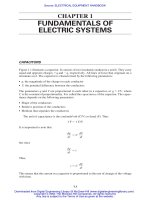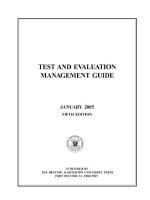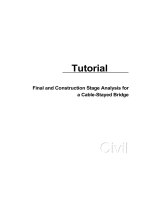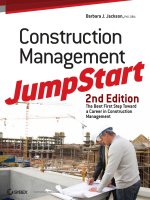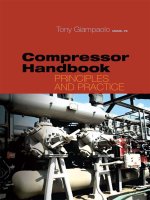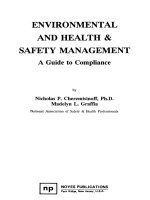Handbook project and construction management
Bạn đang xem bản rút gọn của tài liệu. Xem và tải ngay bản đầy đủ của tài liệu tại đây (817.86 KB, 52 trang )
2011
HANDBOOK
For project and construction management
– Fundamental concepts
“Project coordination” From tender to 5 years inspection - Construction
Management - final version
Københavns Erhvervsakademi and VIA University College,
Horsens
August 2010
00. Introduction
00 Introduction
This handbook is primarily intended for the use by students in their final semester of
the constructing architect education - specializing in construction management.
Construction management aims at a future career as a construction or project
manager working for a contractor.
The handbook will also be useful as a guide for small and medium sized contractors.
The handbook is a joint venture between lecturers in construction management at
VIA University College in Horsens (Vibeke Kragh, Benny Olsen, and Henrik Kopp)
and KEA - Københavns Erhvervsakademi (Eva Weincke, Kaj Torben Hansen, Benny
Lennart Bay, Anders Christensen and Lone Lykke Larsen).
Consequently, the handbook will contain requirements for documentation and other
examples that are not necessarily relevant to contractors, but are deemed relevant for
students.
The handbook is based on practical examples from a fictive contractor. In this
context, relevant aspects from ‘real-life’ contractors will be included. The booklet is
based on project coordination showing the progress in the construction process. The
sections follow project phases from tender to handing over - in a main contractor
contract. As turnkey contracting has been used to an ever increasing degree – this
contract form will also be touched upon.
No rules without exemptions – assignment solutions may have a certain optional
character.
The printed version of the handbook contains:
Specification of the construction process starting with the reception of
tender documents and ending with the 5-year final inspection.
The digital version of the handbook contains:
The above mentioned specification of the construction process as well a
collection of supplementary examples containing relevant
documentation to be used during the construction process – including
examples of the different tools used by the contractor and the project
manager - from tender to 5 year inspection.
Each section will contain links to relevant web pages. By the end of
each section you will find links to supplementary examples.
It is our hope that coming and newly graduated project managers will find inspiration
in the systematic way in which the phases are described.
In order to improve the next edition, we welcome comments on the contents from
experienced project managers.
Original language: Danish
Original title: ’LOGBOG – Oversigt over byggeprocessen for udførende’
Translation by: Karsten Lundager, lecturer, VIA University College, Horsens
Handbook
page 2
00. Introduction
Contents
00
Introduction
.......................................................... 2
01
The contractor
.......................................................... 7
Project management ................................................................................................. 7
Contract forms .......................................................................................................... 8
Risk management ..................................................................................................... 8
Organization and management ................................................................................. 8
Remuneration and conditions of employment .......................................................... 9
Communication and logistics ................................................................................. 10
Quality assurance and management ....................................................................... 10
Environment- and safety management ................................................................... 10
Financial aspects ..................................................................................................... 11
Tender ..................................................................................................................... 11
CEC- construction evaluation centre ...................................................................... 11
Own production ...................................................................................................... 11
Summing up experience ......................................................................................... 12
Legal aspects .......................................................................................................... 12
02 TENDERING
........................................................ 13
Planning the tender ................................................................................................. 13
Contract area definition ......................................................................................... 13
Legal scrutiny ......................................................................................................... 13
Tender form - sub-contractors ............................................................................... 15
Private clients......................................................................................................... 15
The tender is governed by the Danish Act on Tender Procedures ......................... 16
Employment of ministerial order on Price and Time ............................................. 16
Tender for suppliers ................................................................................................ 16
Construction scrutiny ............................................................................................. 17
Geo-technical scrutiny ........................................................................................... 17
Geo-technical scrutiny note ................................................................................... 17
Contract output and construction process .............................................................. 18
Drawings / specifications ....................................................................................... 18
Technical solutions and construction methods. ..................................................... 19
Handbook
page 3
00. Introduction
Risk / responsibility aspects................................................................................... 19
Timeline.................................................................................................................. 20
Calculation of individual trade contracts ................................................................ 20
Tender activities / bid schedule ............................................................................. 20
Direct costs ............................................................................................................ 21
Taking off and time calculation ............................................................................. 21
Wages, material and equipment ............................................................................. 21
Social costs ............................................................................................................ 21
Building site costs .................................................................................................. 22
Indirect costs .......................................................................................................... 22
Supplier and sub-contractor fees ........................................................................... 22
Contribution margin / contribution ratio ............................................................... 22
Key figures............................................................................................................. 22
Calculating main contracts ..................................................................................... 23
Calculation of trade contracts ................................................................................ 24
Calculation of turnkey contracts. ............................................................................ 24
Tender bid ............................................................................................................... 25
Opening tender bids ................................................................................................ 26
03 Contracting
........................................................ 27
Negotiation ............................................................................................................. 27
Cost saving measures ............................................................................................. 27
Savings catalogue ................................................................................................... 27
Contract legislation................................................................................................. 27
Insurances ............................................................................................................... 28
04 Starting up / mobilizing
........................................................ 29
Handing-over project to project manager ............................................................... 29
The building project ............................................................................................... 29
Contract review ...................................................................................................... 29
Time schedule review ............................................................................................ 30
Risk analysis .......................................................................................................... 30
Building site inspection ......................................................................................... 30
Time planning / Time schedules including manning ............................................. 31
Manning and equipment plan ................................................................................ 31
Waste handling ...................................................................................................... 31
Setting out at the builduíng site ............................................................................. 31
Production calculation ........................................................................................... 31
Handbook
page 4
00. Introduction
Finances ................................................................................................................. 32
Chart of accounts ................................................................................................... 32
The individual trade contractor as project manager ............................................... 32
Bid review .............................................................................................................. 33
Suppliers ................................................................................................................ 33
Order- and delivery plan ........................................................................................ 33
WPA and instructions ............................................................................................ 33
Safety work ............................................................................................................ 34
Site meetings .......................................................................................................... 34
Quality assurance ................................................................................................... 34
The main contractor as project manager ................................................................ 34
Folder structure ...................................................................................................... 35
Organization chart for the building project ........................................................... 35
Project examination meetings Projektgennemgangsmøder .................................. 36
Starting-up meeting ............................................................................................... 36
Site and safety meetings ........................................................................................ 36
Process planning .................................................................................................... 36
Plan for health and safety (PHS) ........................................................................... 37
Safety work ............................................................................................................ 37
The exemplary workplace...................................................................................... 38
Registration Anmeldelser ...................................................................................... 38
Building site arrangement plans ............................................................................ 39
Quality assurance ................................................................................................... 39
05
Construction
........................................................ 41
Construction legislation .......................................................................................... 41
Script ...................................................................................................................... 42
General ................................................................................................................... 42
Background ............................................................................................................ 42
Purpose .................................................................................................................. 42
Tools ...................................................................................................................... 42
Coherence with other documents........................................................................... 42
Work drawings....................................................................................................... 43
Management / building project control.................................................................. 43
Meeting agenda ...................................................................................................... 43
Holding meetings ................................................................................................... 44
Handbook
page 5
00. Introduction
Minutes / supervision notes ................................................................................... 44
Signed agreements ................................................................................................. 44
Quality assurance ................................................................................................... 45
The contractor’ quality assurance handbook ......................................................... 45
Control plans.......................................................................................................... 45
Supervision plans ................................................................................................... 46
Sikring og ajourføring samt overholdelse af tidsplanen Follow-up - and keeping
the time plan .......................................................................................................... 46
Payment / construction accounting ......................................................................... 46
Financial follow-up ................................................................................................ 47
Operation and maintenance .................................................................................... 47
06 Handing over
........................................................ 48
Handing over contract ............................................................................................ 48
Handing over with sub-contractors ........................................................................ 49
Final payment ......................................................................................................... 50
1 and 5 years inspections ........................................................................................ 50
07 Summing up experience
........................................................ 51
Introduction ............................................................................................................ 51
Summing up technical risks / experience bank ...................................................... 51
Handbook
page 6
01. The contractor
01 The contractor
Introduction
The contents of this booklet are organized on the basis of an average size contractor,
which could be a turnkey contractor, main contractor or an individual trade
contractor.
No considerations have been given to the corporate form or ownership
The contractor possesses the in-house capacity to carry out for example concrete
works, erection of concrete elements, earthwork operations and sewerage. A
chartered sewerage contractor is often contracted.
The company possesses the equipment necessary to carry out basic tasks but does not
own specialized equipment such as scaffolding and cranes. Due to lack of funds it is
often an advantage to hire equipment rather than owning it.
The main emphasis will be put the contractor working as a main contractor and/or
individual trade contractor.
The contractor is a member of The Danish Construction Association (Dansk
Byggeri) and has a collective agreement with all members of staff.
The company described in the case has not defined any political aims with respect to
such issues as innovation, environment, project sales promotion or personnel policy.
It is, however, of vital importance that the company complies with current
legislation, agreements and codes of practise applicable to this line of business.
For further studies of legislation etc. we refer to The Danish Construction
Association
Project management
The contractor undertakes turnkey contracts as as well as main and individual trade
contracts with a focus on the following key competencies:
Calculation and management of main contracts.
Calculation and implementation of own production within earthwork,
sewerage, concrete works and erection of industrialsed building components.
Rendering different types of service.
Handbook
page 7
01. The contractor
Contract forms
Main contract
Within this contract form the client negotiates with one contractor only. Project
management is transferred from the client to the main contractor. The project
responsibility, however, still belongs to the client.
Grouped contracts
The client may simplify the management to a certain extend by grouping related
trades. In doing so, the coordination and the sharing of responsibility become more
transparent. As it is the case with individual trade contracts, the coordination still
rests with the client, but contrary to the individual trade contracts there will be fewer
contracts to coordinate - and thereby reducing the risk.
Individual trade contract
Typically the client will start by entering a design agreement with an architect and an
engineer. Once the project is ready, the client will enter contracts with a number of
individual trade contractors corresponding to the number of trades involved in the
construction. Coordination and management rests with the client – typically a by
external consultants.
Risk management
In order to ensure the reputation and the earnings of the company and thereby its
survival it is vital to undertake risk management of the project throughout the
building project. The risk management applies to such issues as choice of methods,
choice of equipment, choice of partners, control of client solvency etc.
We have chosen to use the below listed tools in the risk management
Contractor’s checklist of received tender documents
Project journal
Accumulated ’hands-on experience’ from previous projects.
Final evaluation including the summing up of experience gathered
Organization and management
As previously mentioned the company is affiliated to the Danish Construction
Association (Dansk byggeri.)
In the building projects we operate with the following management categories:
Project managers in connection with turnkey contracts and partnering. The
project manager is responsible for the design and construction management.
Construction managers in connection with projects in main contracts. .
The construction manager represents the client in aspects related to the
planning and the implementation of individual trade contracts. In turnkey
Handbook
page 8
01. The contractor
contracts and in partnering the construction manager refers directly to the
project manager. The construction manager has the overall responsibility for
all work on site. He supervises the work and is typically responsible for the
coordination of building site safety.
Individual trade contract managers/clerks of work (CoW) in connection
with individual trade contracts carried out as ’own production’. CoWs refer
directly to the construction manager. It is the responsibility of the CoW to
ensure that the work is carried out within the stipulated time schedule and to
ensure that the necessary work drawings, materials and equipment are present
at the right time in in the specified quantities. It is also the responsibility of
the CoW to ensure and to document the quality of the work carried out.
Further it is the responsibility of the CoW to ensure that all work is carried
out in accordance with current safety regulations and to ensure that Work
Place Assessments (WPAs) are implemented.
Foremen: Management of workers in ’own production’. Is in the hands of
foremen. The foremen are salaried employees and as such they are not
financed through the budget of a particular project.
All managers are qualified safety managers and coordinators. They are also qualified
in the application of the company’s quality assurance system. In addition, the
managers in the company have a well defined (limited) financial free scope.
Other employees such as craftsmen are organized in gangs, represented by a ganger.
The company trains safety representatives to the extend necessary.
All craftsmen are trained in the use of the company’s quality assurance practice.
Remuneration and conditions of employment
The company has entered an agreement with all staff groups and has an interest in
implementing incentive payment systems at all levels.
All members of staff have an employment contract stipulating job description,
remuneration and other conditions.
The company estimates social costs on the basis of current legislation and existing
agreements and based on expenditure during the past year.
All time work should be carried out on the basis of a piece-work contract and we
recommend the use of schedules of wages and time elaborated for each trade. The
company has established an extensive ’time data base’ to be used when assessing the
time required for each task.
All staff sign an employment contract stating job description, renumeration
conditions and other conditions.
In this context it is important to notice observance of Lov om ansættelsesbeviser.
Additional information concerning remuneration and employment conditions may
be found this homepage 3F (union for unskilled workers)
Handbook
page 9
01. The contractor
Communication and logistics
It is considered important that documents, drawings and goods have a continous and
well ooganized flow through the company at all levels. In order to secure this the
company applies tools available.
In the case of turnkey contracts, a CAD manual is used in order to organize the
drawings.
We recommend the use of BIPS folder structure when organizing documents.
In cases where the building project is web based, it is important to ensure that all
parties involved are well trained and informed concerning the terms for document
handling.
In the area of resource management it is important that all trade contractors are
informed about the space made available to each one of them at the building site – as
well as space available for vertical and horizontal transport at the site.
Rolling order – renouncement and supply plans shall be elaborated corresponding to
work progress.
Quality assurance and management
The company has a well-developed quality assurance system to be used irrespective
of the chosen contract form. In this booklet we will use the tools elaborated by The
Danish Construction Association.
Staff members responsible for quality assurance are all trained in the routines and use
of forms worked out by the company. Construction management is well-prepared at
start-up meetings - whether meetings are called by themselves or have been
organized on client’s request
Environment- and safety management
When it comes to safety and an environmental profile, the company is very
ambitions and aspires to receive working environment certification
(arbejdsmiljøcertificeret).
Work Place Assessment (WPA) has been elaborated for all staff groups. All staff
members with management responsibilities are trained safety managers. All involved
parties know their duties - whether they are clients, consultants or employers. All
parties are capable of undertaking the coordination of safety work. They are also able
to work out a Plan for Health and Safety (PHS). The company possesses the
equipment necessary in order to carry out dangerous work, and the construction
management is capable of giving required instruction in the handling of this. A Work
Place Assessment (WPA) is carried out every time dangerous work is carried out.
All employees must undergo training and hold certificates as required by The Danish
Working Environment Authority (arbejdstilsynet). When organizing safety work on
the building site the company uses the so-called 'exemplary work place' as a tool.
A safety organisation with a size corresponding of the number of companies, trades
and employees is established on the building site.
Handbook
page 10
01. The contractor
Financial aspects
The company budget envisages the management’s expectations in relation to
expected turnover as it is distributed on own production, sub-contractors and
additional jobs. Social costs are calculated on the basis of specific company
expenditure, agreement terms and legislation governing the area
When a building project starts the company management works out a cash budget
showing capital needs during the building project in question. A chart account is also
elaborated.
Depending on the extent of the building project, interim calculations and project
stage assessments are elaborated as the project progresses
Final calculations are carried out at the conclusion of a building project.
Tender
The company participates in tenders as individual trade contractors as well as mainand turnkey contractors. In the case of individual trade contracts the company
management calculates directly on the basis of quantities specified in the tender
documents as well as registered site conditions.
Main contract tenders are based on: Calculation of own production cost, tenders
received from sub-contractors and an assessment of additional costs in relation to the
project in question.
Turnkey contract tenders are calculated on the basis of accumulated company
experience (costs of similar projects already implemented) or by the use of
successive calculation – unless it is a tender in accordance to fixed budget. In
connection with the submissions of tenders, a risk analysis is always carried out in
this company.
The contribution ratio is defined on the basis of company overhead costs and the
expected profit.
CEC- construction evaluation centre
The company has a keen interest in entering into competition on large public projects
and therefore aspires to conform to demands for contractors and designers as defined
by The Construction Evaluation Centre (BEC).
Own production
When it comes to own production, the company normally uses employees who have
been affiliated with the company for a longer period of time and with whom the
company has an agreement. In cases where the company undertakes building
projects outside the normal field of practice, it may be necessary to employ staff
from outside the company. In such cases it is necessary to carry out a risk
assessment.
Handbook
page 11
01. The contractor
The company does not own large scale equipment, such as heavy construction
equipment, shuttering and scaffolding. The company only possesses ordinary hand
tools – all other equipment is hired.
Summing up experience
Construction projects inevitably generate enormous and complex amounts of
experience. In most cases this experience is held by a few persons only.
Consequently, a lot of knowledge vanished when members of staff left the company.
At present the company makes a systematic summing up of experience to be used by
cost accountants, clerks of work, construction managers and project managers.
Legal aspects
When a company tenders, a number of legal aspects should be considered. More
information concerning this issue may be found in the section ’Legal scrutiny’.
Enclosures_examples contractor.
Handbook
page 12
02. TENDERING
02 TENDERING
Introduction
Planning the tender
Tendering is a vital part of the company’s activities. It is therefore important to plan
the tender properly and to carry out a systematic scrutiny of the tender documents irrespective of project size, contract/tender form and the extend of ‘own production’.
The company has developed its own procedures with respect to legal and technical
scrutiny as well as risk assessment. Likewise, the procedures for building site
inspection in connection with the tender have been established.
Contract area definition
It is pertinent to make a clear definition of contract area as early as possible in order
to define what parts of the project will be carried out as ’own production’and, what
parts will be carried out by sub-contractors. The main contractor shall also define
what common conditions should apply sub-contractors.
Legal scrutiny
Upon reception of the tender documents, the contractor analyses the documents in
order to identify any conditions that may not be expedient to the main contractor.
A possible outcome of this scrutiny could be that the contractor asks questions to the
client, makes certain reservations in his tender, or chooses not to participate in the
tender at all.
In accordance with AB92 (General Conditions of Work and Supply in Building and
Construction Work) Section 2, subs. 2 , tender bids submitted shall be based on
information in the received tender documents – consequently, it is important to check
that the tender documents received corresponds to the documents mentioned in AB92
Section 2, subs. 2.
The contractor should call attention to whatever errors or shortcomings he might find
in the tender documents in order to avoid a possible repetition of the same mistakes
in the construction works.
The tender documents should mention that AB92 forms the basis of all agreements
in the building project. AB92 defines the rules for the entire building project and
describes how rights and obligations are shared between the client and the
contractor. In principle AB92 should be employed without modifications because
the rules are worked out in such a way that they consider the interest of the client as
well as the contractor. Consequently, the contractor should scrutinize the tender
Handbook
page 13
02. TENDERING
documents in order to identify possible deviations from AB92 which may burden
him with additional obligations towards the client. Should this be the case, the
contractor should seriously consider whether he wants to submit a tender bid.
In case there is a clause in tender documents allowing for the handing in of
alternative bids and in case the tender is ruled by the Danish Act on Tender
Procedures or the EU Directive 2006/123/EC (on public services in the internal
market ) minimum requirements for such bids shall be described in the tender
documents.
In cases where the contractor submits alternative bids he should be aware that he also
takes over the responsibility of designing the alternative solution.
When undertaking a legal scrutiny of a building project, the following aspects shall
be clarified:
The tender may take place in accordance with the Danish Act on Tender Procedures
(Tilbudsloven) , the EU Directive 2006/123/EC (EU´s udbudsdirektiv) or simply in
accordance with the Danish Contracts Act (Aftaleloven). Guidelines can be obtained
from The Danish Competition and Consumer Authority (Konkurrencestyrelsen) .
Through the website Retsinformation you can obtain access to all current legislation.
The rules to be applied depend on who the client is, and as the rules are different it is
imperative to be acquainted with all of them.
1. Is the client private or public?
2. Is it a private construction work with public subsidy?
3. Is part of the agreement based on the Danish Act on Tender Procedures ?
4. Is the total contract sum above the threshold value?
Also the below issues shall be clarified:
1. What type of tender does the client use?
2. Selection criteria and requirements for the fulfilment of these criteria, documentation
etc.
3. Awarding criteria
4. Is it possible to make reservations when a tender is handed in –what kind of
reservations should be made? What type of information shall be handed in at the
same time? And what are the possible consequences of reservations?
1. The tender documents
Contract form
Legislation
Handbook
i.
AB 92
ii.
Governmental order on Fixed Price and Time (Cirkulære om fast
pris og tid )
iii.
Danish Act on Tender Procedures (Tilbudsloven)
iv.
EU Directive 2006/123/EC (EU direktivet)
page 14
02. TENDERING
v.
Governmental order on Quality Assurance
(Kvalitetssikringsbekendtgørelsen )
Insurances
i.
All risks
ii.
Contractor’s insurance
iii.
Building site insurance
Building project specifications
i.
Deviations from standard contract terms.
ii.
Are reservations accepted?
Time schedule
i.
In compliance with AB 92
ii.
Realistic
Bid schedules
Realistic quantities
Is the tender deadline realistic?
Is the bid acceptance period acceptable?
Are contract conditions acceptable?
Sufficient geotechnical analysis?
Tender selection criteria: Lowest price or competition on quality?
2. Is the project under the umbrella of Digital Construction?
Tender form - sub-contractors
In the planning of tenders for sub-contractors it is important to investigate whether
such tenders are subject to special legislation. The tender is always governed by
The Danish Contracts Act (Aftaleloven). In addition the tender may also be governed
by the Danish Act on Tender Procedures (Tilbudsloven).
Next step is to formulate an invitation to tender for the sub-contractors. In this
invitation the tender form must be specified to ensure compliance with the above
mentioned legislation .
Private clients
Private clients are not affected by the Danish Act on Tender Procedures but may
choose to comply with the act.
In case the client chooses not to comply with the Danish Act on Tender Procedures
no specific demands from this act will apply when the main contractor invites
tenders. In this case the tender and accept of tender will be governed by the Danish
Contracts Act.
Handbook
page 15
02. TENDERING
The tender is governed by the Danish Act on Tender
Procedures
In cases where the client is the State, a municipality, a region or a similar public
entity the main contractor must use the Danish Act on Tender Procedures when
inviting tenders from subcontractors – cf. guidelines (Danish Competition and
Consumer Authority) for the Danish Act on Tender Procedures and the Act itself
Employment of governmental order on Price and Time
In case the client is the State the governmental order on Price and Time is employed
guided by the ‘ABC- guidelines’ ( published by the Danish National Housing and
Construction Agency in order to help the interpretation of the Governmental order) .
The standard reservations issued by the Danish Construction Association (Dansk
Byggeri) contain a clause stating that the Governmental order on Price and Time
shall apply to the building project. Consequently, it is natural to include the
governmental order in the sub-contractor’s tender documents.
Tender for suppliers
Tenders for suppliers are not governed by the provisions in the Danish Act on
Tender Procedures (Tilbudsloven) and tenders from suppliers are in most cases
governed by provisions in The Danish Contracts Act (Aftaleloven).
Supplies make take place in accordance with AB92 or in accordance with the
Danish Sale of Goods Act (Købeloven).
In order to secure a uniform set of rules throughout the entire project we recommend
that all supplies take place in accordance with the rules set out in AB92 .
This recommendation applies to tenders from subcontractors as well as tenders from suppliers.
Tender conditions shall be coordinated in relation to tender conditions in the main
contract in such a way that the main contractor does not get into a jam between the
the client on one side and the sub-contractor/supplier on the other side. This may
apply to issues such as payment conditions, consequences of delay, price
adjustments, bid acceptance period etc.
In case the client’s tender documents contain demands with respect to
subcontractors, such demands must also be included in the tender documents
submitted to the subcontractor, cf. for example:
AB 92 § 5 concerning limitation on the rights to transfer obligations
AB 92 § 5 concerning the client’s right to put forward a claim directly against the
contractor’s subcontractors and suppliers
Handbook
page 16
02. TENDERING
Technical scrutiny
The subsequent section covers the contents of the technical scrutiny, including preinvestigations, geo-technical report etc.
From the tenderer’s point of view the objective of the scrutiny is to create the best
possible conditions in order to be able to hand in a precise and complete tender bid
on the day of the tender.
To begin with you must check that you have received all the tender documents
mentioned in the request for tenders.
During the scrutiny process you may come across conditions which are not
adequately defined. Questions relating to such conditions should be brought up at
the clarification meeting in order to shed light on the problem. There will, however,
always exist a small fraction of not sufficiently clarified issues which shall be
included in the risk assessment to be carried out later.
Construction scrutiny
It is recommended that the tenderer visits the future building site at an early stage in
the scrutiny in order to assess access conditions, parking possibilities, neighbouring
conditions, the construction area etc. This is important in order to take into account
possible limitations/ obstacles that might influence the tender bid
Geo-technical scrutiny
A geo-technical report is prepared in most building projects and constitutes part of
the tender documents. An environmental report is quite often prepared as well.
Information in the geo-technical report shall be worked into the tender bid because
soil conditions greatly influence price, time and risk.
The main conclusions in the geo-technical report are most often summarized in it’s
first section, but it is advisable to read the entire report and make notes of the
information found in a so-called ‘scrutiny note’ to be used as the tender phase
progresses.
Geo-technical scrutiny note
The list below describes some of the geo-technical aspects to consider in order to be
well prepared for the calculation of the tender bid. The answers to to the geotechnical questions raised will influence the tender bid directly as well as the risk
assessment.
1. Scrutiny of levels:
Present ground level
Future ground level
Level of topsoil excavation
Handbook
page 17
02. TENDERING
Top level of the stable stratum
Bottom level of foundation
Top level of the solid stratum
Water table)
This information should be noted in a detailed cross section.
2. Soil carrying capacity
Soil strength parameters and carrying capacity
3. Water table
Lowering of the water table?
4. Draining of surface water
Drainage needs, collecting wells and pumping.
5. Excavation
Slope inclination, temporary bunging, conditions on neighbouring plots. Is soil
suitable for backfilling?
6. Building site
Temporary roads, substructures for storage sheds and site huts
7. Environmental problems
Handling polluted soil, pollution degrees.
Contract output and construction process
An overall assessment shall be carried out in order to find out whether the expected
output of the assignment in question matches company competencies.
In order to assess whether sufficient competencies are present, the company produces
an overall plan showing the construction process for the entire building project.
By analysing the the construction process plan of the project in question (imagining
the building process) the management can assess whether the assignment matches
company competencies
Drawings / specifications
Drawings and specifications are thoroughly scrutinized. During this process it is
advisable to ask the following questions: Are project documents adequate? Are
some areas muddled - leaving it up to the contractor to find solutions? Will it be
Handbook
page 18
02. TENDERING
necessary to carry out additional design? Are the materials chosen common and are
they immediately available? Could there be supply problems?
Technical solutions and construction methods.
The buildability of the project is scrutinized with the object of assessing whether
alternative construction methods are obvious. Areas suitable for own production are
identified and areas suitable for sub-contracting will be tendered to subcontractors
and suppliers. It is important to clearly define and delimit such areas.
Risk / responsibility aspects.
Risk management is a relatively new discipline within building construction and it is
at present being systematically introduced.
Risk assessment and risk management are areas to be worked in through all phases of
the building activity.
Starting in the tender phase it is required to assess structures, construction
techniques and such external factors that might imply a risk in order to get an
overview of whatever financial implications this may result in and consequently
include a risk allowance in the tender bid.
.
During the starting up phase it is recommended to get acquainted with individual
work processes and to work out risk analyses for all dangerous work.
During the construction phase the individual foremen shall take part in an
examination of risk analyses and assess how to act in order to minimise the risk.
For more information on methods and diagrams: Risk management in the building
and construction industry (Risikostyring i bygge- og anlægssektoren),
How building site conditions affect contract performance
The building site arrangement is an important aspect of the contractor’s work. The
arrangement affects work progress, safety conditions, construction logistics and the
surrounding environment. The great variety of construction work takes place in very
different surroundings. It is therefore important to carry out a thorough inspection
of the building site conditions, conditions on neighbouring plots, access conditions
and access possibilities for equipment etc.
The client’s/ consultant’s proposal for building site arrangement shall be included in
the tender documents.
We recommend the use of BAR-Ba`s tools for the registration of existing conditions
and for the monitoring of future conditions during construction.
Clarification meeting / cancellation letter
Handbook
page 19
02. TENDERING
Whatever questions may arise during the scrutiny should be brought up at the
clarification meeting. A cancellation letter will subsequently be issued and becomes
a tender document equally important to the the other tender documents
Questions that cannot be answered shall be appraised on the basis of a risk
assessment or it must be defined exactly what output can be expected – it may be
necessary to make reservations
Timeline
The timeline is a planning tool which first of all helps to ensure that such milestones
as the day of tender is reached without too many obstacles and secondly to ensure
that the subsequent project phases are implemented according to time schedule.
The timeline is elaborated on the basis of the tender time schedule, which provides
information about key dates defined by the employer and which must be observed.
Usually these dates are: tender date, time limit for clarification / clarification
meeting, day of tender, expected date of construction commencement and handingover date.
These dates are the skeleton over which the timeline is built and the contractor
supplements with dates for additional activities deemed necessary for the successful
completion of individual project phases .
In a specific building project, an effective tool to use would be a timeline showing
the legal aspects to be considered during the course of the building project in
question
In addition it may be a good idea for the company to work out a time line showing all
ongoing building projects and tender bid calculations as well as upcoming projects.
Very often the tender/bid phase is short and hectic and for that reason a tight
management is important
Calculation of individual trade contracts
In parallel with project scrutiny and the definition of construction methods the
contractor starts the calculation. The calculation is carried out as shown on the
calculation sheet.
The calculation is subdivided into 3 cost categories:
Category 1: Direct costs
Category 2: Indirect costs
Category 3: Other costs
Tender activities / bid schedule
Before the actual quantity surveying of materials and time estimation begins it is
required to subdivide the calculation into sections. Each section refers to the building
Handbook
page 20
02. TENDERING
components / items as stated in the bid schedules being part of the tender documents.
Final prices will be added to the bid schedules at a later stage.
In case the tender documents do not contain bid schedules it will be appropriate to
subdivide the calculation of direct costs into activities clearly indicating a structural
demarcation (for example: Substructure, primary elements, completions etc.)
Within each activity the different work processes, which shall be carried out in order
to complete the said activity, should be stated.
Direct costs
Direct costs include expenses in connection with own production , i.e. labour costs
for tradesmen purchase of materials - with a deduction of discounts - but adding the
cost of waste, hire of equipment, transport, and building site expenses.
Taking off and time calculation
Taking off and estimating time consumption are very important parts of the
contractor’s tender bid. In order to be able to estimate the time consumption
required in relation to the quantities taken off, it is important that the contractor
keeps focus on process quantities, methods applied and waste.
On the basis of the measured quantities and methods applied the time consumption is
determined by the use of price lists elaborated by the various trades and by the use
of the contractor’s own price catalogue (experience cost).
Wages, material and equipment
Special forms, so-called man-hour calculation forms are used when defining the
time required to carry out specific tasks. The time required is determined on the
basis of the agreement (guiding timetable), ‘Anlægs Teknik 2’ or ‘collected data on
time/costs’.
Materials and equipment costs are priced either through tender bids or prices are
found on the internet.
Concealed quantities, material waste and piece rate pay should be taken into
account.
Once the production figures are entered into the calculation, quantities shall be
measured at the building site. Building site expenses are divided into two parts. One
part refers to costs related to the establishment and dismantling of equipment and the
other part relates to operating costs.
Social costs
Upon determination of wages for each activity the social costs are added. Social
costs are paid in accordance with the legislation and in accordance with agreements
in addition to the expenditure the company has had during the past year.
Handbook
page 21
02. TENDERING
Social costs are incorporated in the company budget.
Building site costs
Building site costs include expenditure which is necessary for company staff in
order to perform their trade contracts. Such expenditures could be: site huts, storage
sheds, field workshops including machinery, waste removal, distribution boards and
working lights, health and safety precautions, special tools, tower crane, scaffolding
and hoists/lifts, vehicles for horizontal transport and cutting and bending machine.
Indirect costs
In Denmark, indirect costs are sometimes referred to as ’capacity costs’ because this
type of costs is directly linked to a certain capacity. In this context it is important to
define capacity in its broadest meaning i.e.production, stores, distribution, marketing,
administration etc..
Indirect costs also cover costs related to for example contract managers, foremen
with fixed salary, site accommodation, mileage allowances, tests, security,
unpredictable costs and risk.
Supplier and sub-contractor fees
In cases where a supplier and a subcontractor make part of a given activity, an
additional fee will be added to their (accepted) tender bids. This fee covers
administration and profit.
Finally, the accepted tender + fee is added to the calculated gross price for the
activity, and may hereafter be entered in the bid schedule.
Contribution margin / contribution ratio
The contribution margin expresses in per cent how much profit the contractor
wishes to make on the building project. If the contractor wishes to make 15% profit
on the building project then the direct and social costs will correspond to 85% of the
final tender bid.
Key figures
Once the calculation is finished the contractor should make a note of the relevant key
figures .
Key figures may represent average prices on elements in relevant structures.
The key figures may be entered into a database with a built-in price indexing. By
doing so prices may be re-used in future projects.
Key figures based on experience may be re-used in the following instances:
Handbook
page 22
02. TENDERING
Rough estimates.
As a control measure in new price calculations.
Analysing the choice of new types of construction.
Calculating main contracts
Once the calculation of own production is terminated and tender bids from subcontractors and suppliers have been received and accepted it is possible to begin the
final calculation of the main contract. Like it was the case with the individual trade
contract this calculation is also broken down according to the costs required in the
bid schedule and according to requirements stated in the building project
specifications.
The breakdown may be carried out as follows:
1. Tender bids from sub-contractors with contracts constituting part of the main
contract.
2. Costs related to the building site arrangement and operation
3. Costs related to managing the main contract.
4. Costs related to site accommodation – including furnishings, IT, telephone,
heating etc.
5. Costs related to security / guarantees
6. Costs related to seasonal winter precautions.
7. Costs related to estimated risks.
8. Any other expenses mentioned in the tender documents
Cf 1: Tender bids from the selected sub-contractors (SC) are entered into the form.
The next column contains a percentage indicating the desired administration fee and
profit. Once this is calculated it is possible to determine the amount which must be
entered into the bid schedule (the price we present as ‘our price’ to the client).
Cf 2: Costs related to building site arrangement and operation may be entered in a
separate form where the possibility of carrying out a detailed calculation exists. In
case the building project specifications state that the different SCs shall include costs
related to building site arrangement in their tender bid, such costs will not be added
here since they are already included in the SC’s tender bid. Examples of costs to be
listed here could be: Electricity consumption at the building site, water, fencing,
roads, establishing site accommodation and the like.
Cf 3: Costs related to site management can only be calculated after an organization
chart has been elaborated, clearly stating how many staff will be required in order to
carry out the main contract and for how long they will be stationed at the building
site.
Cf 4: Calculation of costs related to site management accommodation and site hut
may also be carried out in a separate form, and the sum subsequently transferred to
the the main contract summary sheet. .
Cf 5: Costs related to security often amount to a considerable sum - this of course
depends on the magnitude of the main contract.
Handbook
page 23
02. TENDERING
Cf 6: Seasonal winter precautions are calculated and added.
Cf 7: Risks identified during the scrutiny are calculated/estimated and the amount(s)
entered into the calculation such that the funds will be available in case the identified
risks are realized.
Cf 8: Other costs relating to the main contract are entered here.
Cf 9: Depending on the competitive situation it is decided how much should be
charged as administation fee and how much as profit on the main contract.
Costs that cannot / should not be directly entered in the bid schedule such as
expenses related to security /guarantee, risks, profit and maybe construction
management can be distributed evenly across the amounts that must be entered in
the bid schedule. In this way all costs will be reflected in the total tender bid that
must appear in the bid schedule.
In case the tender documents do not contain a bid schedule, you simply add up all
costs and hand in the tender bid.
It is important that the contribution margin corresponds to company demands
regarding earnings.
Calculation of trade contracts
The principles used for the calculation of trade contracts are similar to those used in
the calculation of main contracts.
The trade contractor has own production and employs subcontractors.
Calculation of turnkey contracts.
The calculation of turnkey contracts is similar to the calculation of main contracts.
The calculation does, however, include more costs because it contains all
expenditure in relation to the completely finished building whereas the main
contractor’s tender bid only contains the costs of the items mentioned in the tender
documents.
In addition to costs already mentioned in ’Calculating main contracts’ (above) the
turnkey contract calculation also includes the below listed additional costs:
1. Designing
2. Printing drawings
3. Service charges (sewer, water, electricity, district heating etc.)
4. Planning permission
5. Other expenditures related to the building project in question.
Cf 1: Design expenditure (fees for architect, engineer, landscape architect etc.) shall
be included in the tender bid. The client may have an agreement with an architect in
formulating the project brief and may demand that the turnkey contractor accepts that
final design will be carried out by the same architect but paid by the turnkey
Handbook
page 24
02. TENDERING
contractor. If this is not the case, the turnkey contractor sets his own team of
professionals with whom he wants work and signs an agreement concerning fees. In
most cases the professionals do not receive any payment in case the contract is not
awarded to the turnkey contractor (no cure no pay).
Cf 2: The printing of drawings is quite often a considerable cost and should be
included. In most cases the contractor knows by experience how much the printing
will amount to.
Cf 3 Service charges may be considerable and should be investigated before the
calculation is terminated.
Cf 4: The municipality demands payment for the issuing of a planning permission.
The fee is calculated on the basis of the gross floor area multiplied by a square meter
factor fixed by the municipality.
Cf 5: Other costs related to the project in question are entered here.
Working out the tender bid summary and the filling in of bid schedules (if they exist)
are carried out in the same way as specified in ‘Calculation of main contract’ (see
above).
Tender bid
Once the main contractor / the individual trade contractor has collected all
information needed in order to work out the tender bid, he may complete his bid.
Completion of the bid takes place primarily by filling in the bid schedules and by
drawing up a covering letter to the client.
This information must be included in the covering letter
1)
i.
ii.
iii.
iv.
The basis for tender bid
Invitation to tender
Minutes from clarification meetings
Cancellation letters related to tender documents
Relevant legislation
2)
Assumptions constituting the basis for the tender bid
3)
Reservations – if any
We recommend that the contractor seriously contemplates the need to make
reservations because he may risk that his reservations are considered ineligible (not
acceptable). In case reservations are made it is recommended to use the standard
reservations issued by the Danish Construction Association – minus whatever
reservations that may conflict with the tender documents.
It is very important that the contractor double checks his bid before it is handed in.
According to the Danish Contracts Act a bid is binding upon the tenderer once it has
been ‘revealed to the client’. In principle the tenderer cannot revoke the bid after it
has been communicated to the client.
Handbook
page 25

